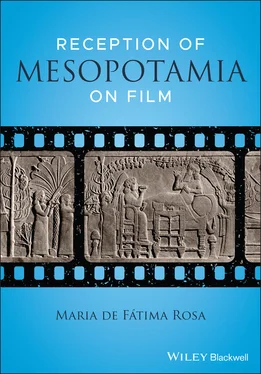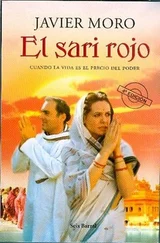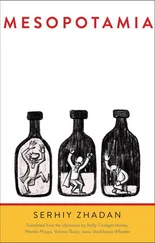Reception of Mesopotamia on Film
Maria de Fátima Rosa
NOVA University LisbonLisbon, Portugal

This edition first published 2022
© 2022 John Wiley & Sons, Inc.
All rights reserved. No part of this publication may be reproduced, stored in a retrieval system, or transmitted, in any form or by any means, electronic, mechanical, photocopying, recording or otherwise, except as permitted by law. Advice on how to obtain permission to reuse material from this title is available at http://www.wiley.com/go/permissions.
The right of Maria de Fátima Rosa to be identified as the author of this work has been asserted in accordance with law.
Registered Office
John Wiley & Sons, Inc., 111 River Street, Hoboken, NJ 07030, USA
Editorial Office
111 River Street, Hoboken, NJ 07030, USA
For details of our global editorial offices, customer services, and more information about Wiley products visit us at www.wiley.com.
Wiley also publishes its books in a variety of electronic formats and by print-on-demand. Some content that appears in standard print versions of this book may not be available in other formats.
Limit of Liability/Disclaimer of Warranty
While the publisher and authors have used their best efforts in preparing this work, they make no representations or warranties with respect to the accuracy or completeness of the contents of this work and specifically disclaim all warranties, including without limitation any implied warranties of merchantability or fitness for a particular purpose. No warranty may be created or extended by sales representatives, written sales materials or promotional statements for this work. The fact that an organization, website, or product is referred to in this work as a citation and/or potential source of further information does not mean that the publisher and authors endorse the information or services the organization, website, or product may provide or recommendations it may make. This work is sold with the understanding that the publisher is not engaged in rendering professional services. The advice and strategies contained herein may not be suitable for your situation. You should consult with a specialist where appropriate. Further, readers should be aware that websites listed in this work may have changed or disappeared between when this work was written and when it is read. Neither the publisher nor authors shall be liable for any loss of profit or any other commercial damages, including but not limited to special, incidental, consequential, or other damages.
Library of Congress Cataloging-in-Publication Data
Names: de Fátima Rosa, Maria, 1981- author.
Title: Reception of Mesopotamia on film / Maria de Fátima Rosa.
Description: Hoboken : John Wiley & Sons, Inc., [2022] | Includes bibliographical references and index.
Identifiers: LCCN 2021009104 (print) | LCCN 2021009105 (ebook) | ISBN 9781119778646 (paperback) | ISBN 9781119778660 (pdf) | ISBN 9781119778653 (epub) | ISBN 9781119778677 (ebook)
Subjects: LCSH: Civilization, Assyro-Babylonian, in motion pictures. | Iraq--In motion pictures. | Iraq--Civilization--To 634.
Classification: LCC PN1995.9.C517 D4 2022 (print) | LCC PN1995.9.C517 (ebook) | DDC 791.430935--dc23
LC record available at https://lccn.loc.gov/2021009104LC ebook record available at https://lccn.loc.gov/2021009105
Cover image: © Werner Forman/Contributor/Universal Images Group/Getty Images, © 32 pixels/Shutterstock
Cover design by Wiley
Set in 9.5/12.5 STIXTwoText by Integra Software Services Pvt. Ltd, Pondicherry, India
For my brother Emanuel,
In memory of the movies of our childhood and the yearnings of our adult lives.
Until our reunion.
1 Cover
2 Title page Reception of Mesopotamia on Film Maria de Fátima Rosa NOVA University LisbonLisbon, Portugal
3 Copyright
4 Dedication
5 List of Abbreviations
6 Acknowledgements
7 Introduction 0.1 Reception Studies and Cinema 0.2 Why Cinema? What Cinema? 0.3 Orientalism and the Legacy of Ancient Mesopotamia
8 Part I: The Pre-Cinematographic Image: A Complex Plot Chapter 1: The Old Testament Paradigm and the Romanticism of the Classics 1.1 The Genesis of Confusion1.1.1 From Babylon to Babel1.1.2 In the Beginning, Nimrod1.1.3 Daniel and the Ruin of the Neo-Babylonian Empire1.2 Greek Ethnocentricity and the Emergence of Legendary Figures1.2.1 A discourse About the Other1.2.2 The Subversion of Roles: The Dilution of the Male/Female Binomial Chapter 2: Mesopotamia in Literature and on Stage 2.1 The Resurrection of Classical Legendary Figures2.2 Tragic Mesopotamian Heroes and Their Dramatization2.2.1 Semiramis from Manfredi to Rossini2.2.2 Sardanapalus, Myrrah and Their Fateful Destiny2.2.3 The Various Nabuccos Chapter 3: The Appropriation and Visual Reproduction of Assyria and Babylon 3.1 Mesopotamia Pre-Discovered: Testimonies from an Unknown World3.2 The Archaeological Exploration3.3 Mesopotamia Post-discovered: The Introduction of Assyrianizing Elements
9 Part II: The Portrayal of Mesopotamia in Cinema Chapter 4: Genres and Cinematographic Contexts 4.1 Why Antiquity?4.2 Early French Cinema and Its Motivations4.3 American Cinema, the Epic Genre, and the Judeo-Christian Legacy4.4 Italian Cinema and the Greco-Roman Heritage4.4.1 The First Golden Age4.4.2 Peplum and the Genesis of the West Chapter 5: Mesopotamia as the Seed of Evil 5.1 Resurrecting Ancient Near Eastern Demons5.2 Present Speeches From an Ancient Demoniacal Past5.2.1 Religious Narratives: The Apocalypse and the Whore of Babylon5.2.2 Political Narratives: Communism, Capitalism, Nazism, and Terrorism Chapter 6: Imagining the Land Between the Rivers: Urbanism and Culture 6.1 The City as a Privileged Setting6.1.1 The Hyperbolizing of Urban Architecture6.1.2 The Polarization of the City: Palace and Temple6.2 The Ziggurat Tower: Babel Intertwining Past and Present6.3 Exoticism and Modernism: Colliding Worlds in Mesopotamia6.3.1 Hybridism and Advance Machinery in the Era of Industrial Revival6.3.2 Universalizing Mesopotamia in Post-Fascist Italy Chapter 7: Exploring Mesopotamia’s Society and Politics 7.1 A Portrait of the King and Queen and Their Population7.1.1 Eastern Stereotypes and Socio-political Contexts7.1.2 The Mesopotamian Fascist vs. the Mesopotamian Apostle of Tolerance7.2 Religion and Politics7.2.1 Gods at War: Idolatry, Holocaust and the Judeo-Christian Faith7.2.2 It’s Every Man for Himself Chapter 8: Helping Without Hurting 8.1 Judith against Assyria8.1.1 Female Emancipation vs. Biblical Conservatism8.1.2 The Debate Regarding the “New Woman”8.2 The Two Semiramis8.3 Mesopotamian Bacchanals and Odd Rituals Chapter 9: Farewell Babylon, Farewell Nineveh
10 Bibliography
11 Index
12 End User License Agreement
1 Chapter 1Figure 1.1. James Tissot, The Flight of the Prisoners.Figure 1.2. Martyrs chrétiens, a film by Lucien Nonguet..
2 Chapter 2Figure 2.1. Woodcut illustration of Semiramis from an incunable German...Figure 2.2. SéSémiramis, a film by Camille de Morlhon.Figure 2.3. The Gate of Imgur Bel with Assyrian winged bulls...
3 Chapter 3Figure 3.1. Engraving by Gustave Doré entitled The..Figure 3.2. Still from the movie Metropolis (1927).Figure 3.3. Belshazzar’s Feast (1820) by John Martin. Public domain.
Читать дальше













